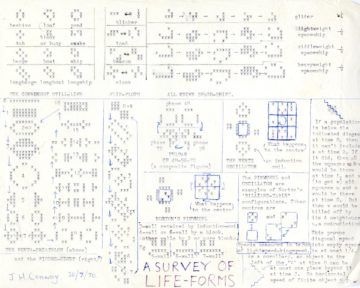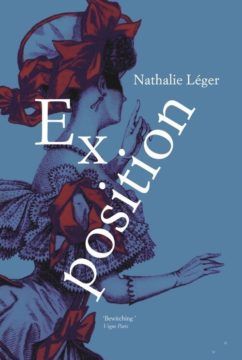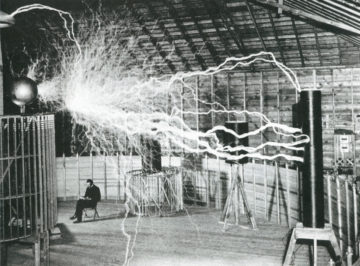Siobhan Roberts in The New York Times:
 In March of 1970, Martin Gardner opened a letter jammed with ideas for his Mathematical Games column in Scientific American. Sent by John Horton Conway, then a mathematician at the University of Cambridge, the letter ran 12 pages, typed hunt-and-peck style. Page 9 began with the heading “The game of life.” It described an elegant mathematical model of computation — a cellular automaton, a little machine, of sorts, with groups of cells that evolve from iteration to iteration, as a clock advances from one second to the next. Dr. Conway, who died in April, having spent the latter part of his career at Princeton, sometimes called Life a “no-player, never-ending game.” Mr. Gardner called it a “fantastic solitaire pastime.” The game was simple: Place any configuration of cells on a grid, then watch what transpires according to three rules that dictate how the system plays out.
In March of 1970, Martin Gardner opened a letter jammed with ideas for his Mathematical Games column in Scientific American. Sent by John Horton Conway, then a mathematician at the University of Cambridge, the letter ran 12 pages, typed hunt-and-peck style. Page 9 began with the heading “The game of life.” It described an elegant mathematical model of computation — a cellular automaton, a little machine, of sorts, with groups of cells that evolve from iteration to iteration, as a clock advances from one second to the next. Dr. Conway, who died in April, having spent the latter part of his career at Princeton, sometimes called Life a “no-player, never-ending game.” Mr. Gardner called it a “fantastic solitaire pastime.” The game was simple: Place any configuration of cells on a grid, then watch what transpires according to three rules that dictate how the system plays out.
Birth rule: An empty, or “dead,” cell with precisely three “live” neighbors (full cells) becomes live.
Death rule: A live cell with zero or one neighbors dies of isolation; a live cell with four or more neighbors dies of overcrowding.
Survival rule: A live cell with two or three neighbors remains alive.
With each iteration, some cells live, some die and “Life-forms” evolve, one generation to the next. Among the first creatures to emerge was the glider — a five-celled organism that moved across the grid with a diagonal wiggle and proved handy for transmitting information. It was discovered by a member of Dr. Conway’s research team, Richard Guy, in Cambridge, England. The glider gun, producing a steady stream of gliders, was discovered soon after by Bill Gosper, then at the Massachusetts Institute of Technology.
More here.
 It’s important to see the full opportunity waiting ahead. Each planet or moon is its own world, with its own history and story to tell, and its own potential (however one might define this) for the future. Though mostly barren of life, they are far from empty; many are chock-full of the materials that would go into life-generating goo: sugars, amino acids, carboxylic acids and powerful molecules that drive reactions away from equilibrium. On bodies where widespread life might not be possible, many of them nevertheless contain microniches where life can take root and flourish for billions of years. Conceivably, for every planet that crossed the threshold of biogenesis, there were scores more that came part or even most of the way that just missed the nudge to do so.
It’s important to see the full opportunity waiting ahead. Each planet or moon is its own world, with its own history and story to tell, and its own potential (however one might define this) for the future. Though mostly barren of life, they are far from empty; many are chock-full of the materials that would go into life-generating goo: sugars, amino acids, carboxylic acids and powerful molecules that drive reactions away from equilibrium. On bodies where widespread life might not be possible, many of them nevertheless contain microniches where life can take root and flourish for billions of years. Conceivably, for every planet that crossed the threshold of biogenesis, there were scores more that came part or even most of the way that just missed the nudge to do so.
 Exposition, Suite for Barbara Loden, and The White Dress are literary works of research. Léger is the Director of the Institut Mémoires de l’Édition Contemporaine (Institute for Contemporary Publishing Archives), so it is unsurprising that archives and the figure of the archive should feature in her work. What is perhaps more notable is the way in which Léger sees the archive as a literary space. In
Exposition, Suite for Barbara Loden, and The White Dress are literary works of research. Léger is the Director of the Institut Mémoires de l’Édition Contemporaine (Institute for Contemporary Publishing Archives), so it is unsurprising that archives and the figure of the archive should feature in her work. What is perhaps more notable is the way in which Léger sees the archive as a literary space. In  The tenth-century epic poem, Beowulf, is the longest surviving poem in Old English. Before the poem was transcribed in a single manuscript, now known as “The Nowell Codex, it was orally transmitted, which explains the alliteration, metrical structure, and memory aids alluding to previous events. At a surface-level, the poem is about a Geatish warrior who is employed to kill monsters, becomes king, and then gets killed by a dragon. Moreover, the poem also gives us some insight into the sociocultural context of early medieval England—the poem considers the politics of the comitatus bond (the relationship between lord and retainer), the history of several Germanic tribes, and as some scholars note, the transition from paganism to Christianity.
The tenth-century epic poem, Beowulf, is the longest surviving poem in Old English. Before the poem was transcribed in a single manuscript, now known as “The Nowell Codex, it was orally transmitted, which explains the alliteration, metrical structure, and memory aids alluding to previous events. At a surface-level, the poem is about a Geatish warrior who is employed to kill monsters, becomes king, and then gets killed by a dragon. Moreover, the poem also gives us some insight into the sociocultural context of early medieval England—the poem considers the politics of the comitatus bond (the relationship between lord and retainer), the history of several Germanic tribes, and as some scholars note, the transition from paganism to Christianity. The human sense of smell is far more acute than previously thought, yet it is still commonly believed that there is no language of smell.
The human sense of smell is far more acute than previously thought, yet it is still commonly believed that there is no language of smell. Of the Corona vaccine doses available each week, 1% should be auctioned off to the highest bidders and the money given to to humanitarian charities like the Red Cross and Salvation Army. This will ensure that the limited amount of vaccine we now have will achieve the most good. Perhaps more surprisingly, it will also be fairer.
Of the Corona vaccine doses available each week, 1% should be auctioned off to the highest bidders and the money given to to humanitarian charities like the Red Cross and Salvation Army. This will ensure that the limited amount of vaccine we now have will achieve the most good. Perhaps more surprisingly, it will also be fairer. H
H In March of 1970, Martin Gardner opened a letter jammed with ideas for his Mathematical Games column in Scientific American. Sent by John Horton Conway, then a mathematician at the University of Cambridge, the letter ran 12 pages, typed hunt-and-peck style. Page 9 began with the heading “The game of life.” It described an elegant mathematical model of computation — a cellular automaton, a little machine, of sorts, with groups of cells that evolve from iteration to iteration, as a clock advances from one second to the next. Dr. Conway, who
In March of 1970, Martin Gardner opened a letter jammed with ideas for his Mathematical Games column in Scientific American. Sent by John Horton Conway, then a mathematician at the University of Cambridge, the letter ran 12 pages, typed hunt-and-peck style. Page 9 began with the heading “The game of life.” It described an elegant mathematical model of computation — a cellular automaton, a little machine, of sorts, with groups of cells that evolve from iteration to iteration, as a clock advances from one second to the next. Dr. Conway, who  The strangeness of electricity seemed to be that it was at once “so moveable and incapable of rest” and yet also capable of being arrested if deprived of a suitable conductor, for example, by the air. This latter had been demonstrated most dramatically by the experiments of Stephen Gray in the early 1700s, who had electrified charity boys, an ample supply of which was furnished by Charterhouse where he was resident, hung from silken cords in mid-air. The sense that electricity belongs naturally to “the more hidden properties of the air” is borne out by the fact that so many demonstrations and depictions showed electrified subjects who were themselves suspended in midair (even though the reason for this is actually to use the air as insulation). Charles Burney, the father of the novelist Fanny, recorded in 1775 his terror at being caught in a thunderstorm in Bavaria, and his wish for a bed off the ground, so he might sleep in safety “suspended by silk cords in the middle of a large room.”
The strangeness of electricity seemed to be that it was at once “so moveable and incapable of rest” and yet also capable of being arrested if deprived of a suitable conductor, for example, by the air. This latter had been demonstrated most dramatically by the experiments of Stephen Gray in the early 1700s, who had electrified charity boys, an ample supply of which was furnished by Charterhouse where he was resident, hung from silken cords in mid-air. The sense that electricity belongs naturally to “the more hidden properties of the air” is borne out by the fact that so many demonstrations and depictions showed electrified subjects who were themselves suspended in midair (even though the reason for this is actually to use the air as insulation). Charles Burney, the father of the novelist Fanny, recorded in 1775 his terror at being caught in a thunderstorm in Bavaria, and his wish for a bed off the ground, so he might sleep in safety “suspended by silk cords in the middle of a large room.” Ralph Steadman was born in Liverpool in 1936, and during the Second World War his family relocated to North Wales. Having honed his technical drawing skills during military service, he moved to London in the 1950s and started work as a cartoonist. Over the course of his 60-year career, Steadman has illustrated classics such as Animal Farm, drawn album covers for bands including the Who, and produced scathing political caricatures for publications on both sides of the Atlantic (he has been contributing to the New Statesman since 1976). He is perhaps best known for his collaborations with the American gonzo journalist Hunter S Thompson, particularly for Thompson’s 1971 novel Fear and Loathing in Las Vegas. Steadman’s provocative, ink-splattered images – some of which, taken from a major new book, are reprinted here – are informed by his philosophy: “There is no such thing as a mistake. A mistake is an opportunity to do something else.”
Ralph Steadman was born in Liverpool in 1936, and during the Second World War his family relocated to North Wales. Having honed his technical drawing skills during military service, he moved to London in the 1950s and started work as a cartoonist. Over the course of his 60-year career, Steadman has illustrated classics such as Animal Farm, drawn album covers for bands including the Who, and produced scathing political caricatures for publications on both sides of the Atlantic (he has been contributing to the New Statesman since 1976). He is perhaps best known for his collaborations with the American gonzo journalist Hunter S Thompson, particularly for Thompson’s 1971 novel Fear and Loathing in Las Vegas. Steadman’s provocative, ink-splattered images – some of which, taken from a major new book, are reprinted here – are informed by his philosophy: “There is no such thing as a mistake. A mistake is an opportunity to do something else.” Anyone who has been a teenager or dressed a 4-year-old knows that what we wear can be a source of intense conflict. Clothing is more than essential protection against the elements. It helps define who we are—to the world and to ourselves. And it is an everyday source of aesthetic pleasure. Clothing is a form of self-expression.
Anyone who has been a teenager or dressed a 4-year-old knows that what we wear can be a source of intense conflict. Clothing is more than essential protection against the elements. It helps define who we are—to the world and to ourselves. And it is an everyday source of aesthetic pleasure. Clothing is a form of self-expression. When the Khoisan hunter-gatherers of sub-Saharan Africa gazed upon the meandering trail of stars and dust that split the night sky, they saw the embers of a campfire. Polynesian sailors perceived a cloud-eating shark. The ancient Greeks saw a stream of milk, gala, which would eventually give rise to the modern term “galaxy.”
When the Khoisan hunter-gatherers of sub-Saharan Africa gazed upon the meandering trail of stars and dust that split the night sky, they saw the embers of a campfire. Polynesian sailors perceived a cloud-eating shark. The ancient Greeks saw a stream of milk, gala, which would eventually give rise to the modern term “galaxy.” Archaeologists in Pompeii, the city buried in a volcanic eruption in 79 AD, have made the extraordinary find of a frescoed hot food and drinks shop that served up the ancient equivalent of street food to Roman passersby.
Archaeologists in Pompeii, the city buried in a volcanic eruption in 79 AD, have made the extraordinary find of a frescoed hot food and drinks shop that served up the ancient equivalent of street food to Roman passersby. When she began writing “
When she began writing “ This annus horribilis is not over yet, and it has now taken away from us the greatest doyen and scholar of Urdu literature the world knew over the recent decades, Shamsur Rahman Faruqi. He died peacefully at his home, surrounded by his family and his favourite dogs, having recovered earlier this month from Covid-19. I had the honour and pleasure to visit him in his study in January this year, which isn’t anything less than a library. It is hard to imagine all those books siting there without their avid reader. Ghalib’s often quoted verse “aisā kahan se laun ki tujh saa kahen jise” – “where do I find another who may be like you?” – doesn’t seem to hold truer than in this moment of the greatest loss for Urdu culture.
This annus horribilis is not over yet, and it has now taken away from us the greatest doyen and scholar of Urdu literature the world knew over the recent decades, Shamsur Rahman Faruqi. He died peacefully at his home, surrounded by his family and his favourite dogs, having recovered earlier this month from Covid-19. I had the honour and pleasure to visit him in his study in January this year, which isn’t anything less than a library. It is hard to imagine all those books siting there without their avid reader. Ghalib’s often quoted verse “aisā kahan se laun ki tujh saa kahen jise” – “where do I find another who may be like you?” – doesn’t seem to hold truer than in this moment of the greatest loss for Urdu culture. Bill McKibben in The New Yorker:
Bill McKibben in The New Yorker: